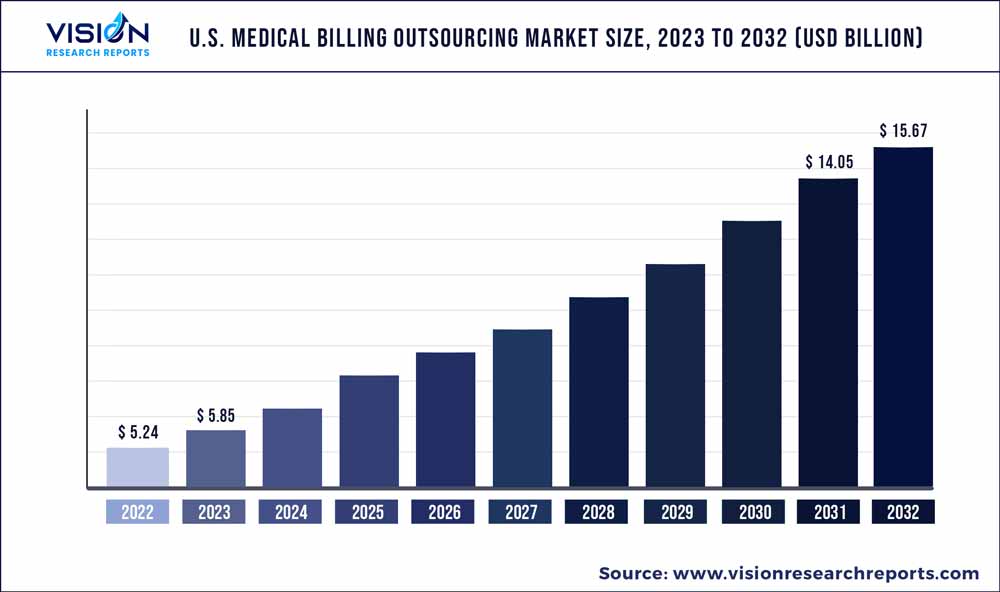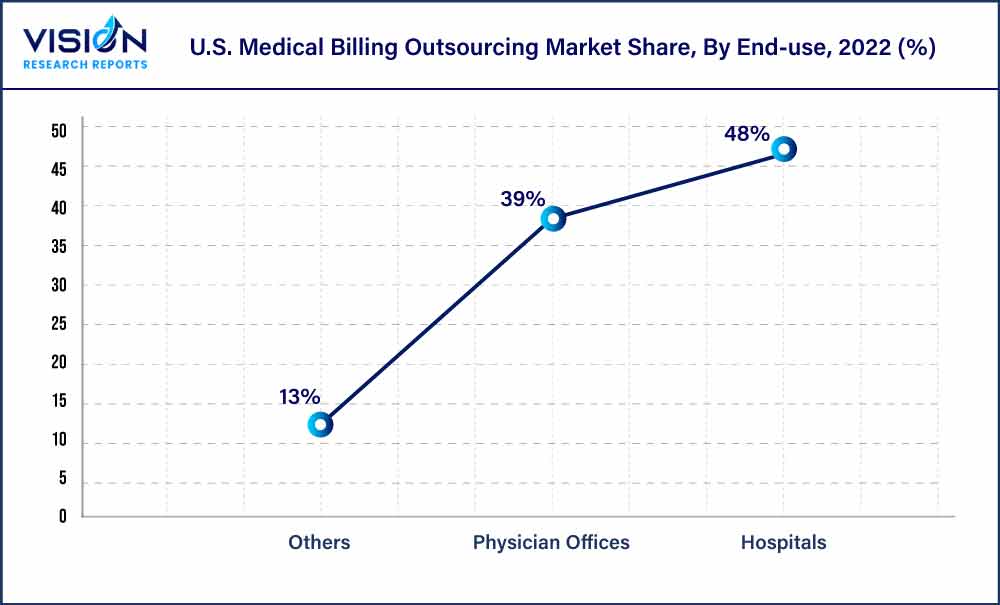The U.S. medical billing outsourcing market size was estimated at around USD 5.24 billion in 2022 and it is projected to hit around USD 15.67 billion by 2032, growing at a CAGR of 11.58% from 2023 to 2032.

Key Pointers
Report Scope of the U.S. Medical Billing Outsourcing Market
| Report Coverage | Details |
| Market Size in 2022 | USD 5.24 billion |
| Revenue Forecast by 2032 | USD 15.67 billion |
| Growth rate from 2023 to 2032 | CAGR of 11.58% |
| Base Year | 2022 |
| Forecast Period | 2023 to 2032 |
| Market Analysis (Terms Used) | Value (US$ Million/Billion) or (Volume/Units) |
| Companies Covered | R1RCM Inc.; Veradigm LLC (Allscripts Healthcare, LLC); Oracle (Cerner Corporation); eClinicalWorks; Kareo, Inc.; McKesson Corporation; Quest Diagnostics Incorporated; Promantra Inc.; AdvancedMD, Inc. |
Medical billing involves revenue cycle management (RCM), which comprises ofverycrucial and sophisticated components of the healthcare IT business. Healthcare service providers are facing numerous challenges in managing a large volume of claims and reimbursements, resulting in major revenue losses. Owing to this, the demand for medical billing outsourcing services is increasing in the U.S. The rising patient load and the need to address the ever-growing record and bills are creating a burden on medical practitioners. To counter such a situation, hospitals are outsourcing the medical billing process which is expected to drive the growth of the market.
For instance, in October 2021, American Physician Partners (APP), a major player in emergency and intensive care management services extended its contract with R1 RCM Inc. till 2031. The partnership was first established in 2019 and is extended to streamline operations and scale up performance.
The rules and regulations for health insurance in the U.S. are constantly changing and hospitals are struggling to keep up with the rapidly changing reimbursement environment. The current revenue cycle management practices are becoming obsolete mainly because of the dearth of expertise without a thorough understanding of new payment models and RCM tools. Keeping pace with rapid changes in the industry and constantly remaining updated with expanding knowledge base are time-consuming and tedious processes for businesses.
Hence, outsourced RCM services are the best option for hospitals and other medical institutions. U.S. hospitals partner with outsourcing companies that bring in end-to-end knowledge of the Affordable Medical Care Act, Medicaid, and other healthcare and insurance programs. RCM practices involve high technological sophistication, coupled with trained expertise. The increasing implementation of several healthcare IT platforms has been positively influencing the growth of the market.
Hassle-free process of settling claims with features such as accounts receivable management and claims management and the availability of professional coders acquainted with the latest medical codes are the primary driving forces behind practices opting to outsource their billing services. However, the high threats of data breaches associated with medical billing in the U.S. are expected to hinder the growth of the market during the forecast period. For instance, in November 2022, the Department of Health and Human Services website reported 595 breaches in the year, affecting over 40 million individuals.
The pandemic has had some positive as well as negative effects on the market. The introduction of new ICD codes, Current Procedural Terminology (CPT) codes, and diagnosis codes for COVID-19 billing and telehealth billing has posed a greater challenge for medical billing service providers. On the other hand, the adoption of RCM increased in the U.S. For instance, as per a survey conducted by AKASA, nearly 75% of the health systems in the U.S. have deployed RCM solutions during the pandemic.
Component Insights
By component, the market is bifurcated into in-house and outsourced. The outsourced segment held the largest revenue share of 57% in 2022 and is expected to register the fastest growth. According to a 2018 study in the Journal of Medical Practice Management, practices that outsource their billing had higher rates of claims paid on the first submission (80%) and within 30 days (88%) compared to practices that handle their own billing (68% and 72%, respectively).
On the other hand, outsourcing activity significantly reduces costs and proves a good fit for small and medium practices. To reduce healthcare costs, increase profit margins, and improve patient-physician relationships, various hospitals, and independent physicians are turning towards outsourcing billing services. This trend is in line with the latest research. the Medical Group Management Association (MGMA) conducted a survey that revealed the average cost of collecting a dollar from payers was 13.7% in 2021, for practices handling their own billing, while those outsourcing their billing incurred a lower cost of 5.4%.
Furthermore, a doctor could not provide the best possible care to patients if he/she is engaged in managing administrative processes, such as recovering claims and managing bills. Hence, to enhance the focus on medical care, large hospitals started outsourcing these services.
Service Insights
Based on service, the U.S. medical billing outsourcing market is segmented into front-end services, middle-end services, and back-end services. The front-end services segment dominated the market with a share of 40% in 2022. It consists of processes such as scheduling, preregistration, registration, eligibility, insurance verification, and pre-authorization. Managing front-end services well remains important for reducing repetitive work and improving the patient experience with faster service. Therefore, the demand for outsourcing these services is robust. Middle-end services are anticipated to witness maximum growth in the coming years due to the entry of new market players, growing awareness among healthcare practitioners, and increasing adoption of services.
The rising number of claim denials due to inefficient claim management and the increasing burden on the front-end service providers is likely to propel the demand for back-end services. Back-end services minimize the burden of front-end services. For instance, according to the report of the advisory board of RevCycle Intelligence, around 90% of denial of claims can be prevented and can be corrected for payment but are never resubmitted to payers due to a lack of focus.
End-use Insights
In terms of end-use, the hospital segment accounted for the largest revenue share of 48% of the U.S. medical billing outsourcing market in 2022. Hospitals are the prime users of outsourcing services due to the high claim volume. Consolidations of hospitals further increase the complexity of billing and reimbursement procedures. This is fueling segment growth. The majority of hospitals and healthcare facilities are shifting towards RCM services to minimize errors and find a cost-effective solution. For instance, in December 2021, Allied Digestive Health, a Northeast-based gastroenterology treatment provider, selected Athenahealth Inc. for its patient engagement service and medical billing.

The physician offices segment is projected to witness substantial growth during the forecast period. The soaring need to build more cost-effective and efficient processes and to manage the increased emphasis on compliance and risk management by regulatory authorities are supplementing the growth of the segment.
U.S. Medical Billing Outsourcing Market Segmentations:
By Component
By Service
By End-use
Chapter 1. Introduction
1.1. Research Objective
1.2. Scope of the Study
1.3. Definition
Chapter 2. Research Methodology
2.1. Research Approach
2.2. Data Sources
2.3. Assumptions & Limitations
Chapter 3. Executive Summary
3.1. Market Snapshot
Chapter 4. Market Variables and Scope
4.1. Introduction
4.2. Market Classification and Scope
4.3. Industry Value Chain Analysis
4.3.1. Raw Material Procurement Analysis
4.3.2. Sales and Distribution Component Analysis
4.3.3. Downstream Buyer Analysis
Chapter 5. COVID 19 Impact on U.S. Medical Billing Outsourcing Market
5.1. COVID-19 Landscape: U.S. Medical Billing Outsourcing Industry Impact
5.2. COVID 19 - Impact Assessment for the Industry
5.3. COVID 19 Impact: Major Government Policy
5.4. Market Trends and Opportunities in the COVID-19 Landscape
Chapter 6. Market Dynamics Analysis and Trends
6.1. Market Dynamics
6.1.1. Market Drivers
6.1.2. Market Restraints
6.1.3. Market Opportunities
6.2. Porter’s Five Forces Analysis
6.2.1. Bargaining power of suppliers
6.2.2. Bargaining power of buyers
6.2.3. Threat of substitute
6.2.4. Threat of new entrants
6.2.5. Degree of competition
Chapter 7. Competitive Landscape
7.1.1. Company Market Share/Positioning Analysis
7.1.2. Key Strategies Adopted by Players
7.1.3. Vendor Landscape
7.1.3.1. List of Suppliers
7.1.3.2. List of Buyers
Chapter 8.U.S. Medical Billing Outsourcing Market, By Component
8.1. U.S. Medical Billing Outsourcing Market, by Component, 2023-2032
8.1.1 In-house
8.1.1.1. Market Revenue and Forecast (2020-2032)
8.1.2. Outsourced
8.1.2.1. Market Revenue and Forecast (2020-2032)
Chapter 9. U.S. Medical Billing Outsourcing Market, By Service
9.1. U.S. Medical Billing Outsourcing Market, by Service, 2023-2032
9.1.1. Front-end services
9.1.1.1. Market Revenue and Forecast (2020-2032)
9.1.2. Middle-end services
9.1.2.1. Market Revenue and Forecast (2020-2032)
9.1.3. Back-end services
9.1.3.1. Market Revenue and Forecast (2020-2032)
Chapter 10. U.S. Medical Billing Outsourcing Market, By End-use
10.1. U.S. Medical Billing Outsourcing Market, by End-use, 2023-2032
10.1.1. Hospitals
10.1.1.1. Market Revenue and Forecast (2020-2032)
10.1.2. Physician Offices
10.1.2.1. Market Revenue and Forecast (2020-2032)
10.1.3. Others
10.1.3.1. Market Revenue and Forecast (2020-2032)
Chapter 11. U.S. Medical Billing Outsourcing Market, Regional Estimates and Trend Forecast
11.1. U.S.
11.1.1. Market Revenue and Forecast, by Component (2020-2032)
11.1.2. Market Revenue and Forecast, by Service (2020-2032)
11.1.3. Market Revenue and Forecast, by End-use (2020-2032)
Chapter 12. Company Profiles
12.1. R1RCM Inc.
12.1.1. Company Overview
12.1.2. Product Offerings
12.1.3. Financial Performance
12.1.4. Recent Initiatives
12.2. Veradigm LLC (Allscripts Healthcare, LLC).
12.2.1. Company Overview
12.2.2. Product Offerings
12.2.3. Financial Performance
12.2.4. Recent Initiatives
12.3. Oracle (Cerner Corporation)
12.3.1. Company Overview
12.3.2. Product Offerings
12.3.3. Financial Performance
12.3.4. Recent Initiatives
12.4. eClinicalWorks.
12.4.1. Company Overview
12.4.2. Product Offerings
12.4.3. Financial Performance
12.4.4. Recent Initiatives
12.5. Kareo, Inc.
12.5.1. Company Overview
12.5.2. Product Offerings
12.5.3. Financial Performance
12.5.4. Recent Initiatives
12.6. McKesson Corporation
12.6.1. Company Overview
12.6.2. Product Offerings
12.6.3. Financial Performance
12.6.4. Recent Initiatives
12.7. Quest Diagnostics Incorporated.
12.7.1. Company Overview
12.7.2. Product Offerings
12.7.3. Financial Performance
12.7.4. Recent Initiatives
12.8. Promantra Inc.
12.8.1. Company Overview
12.8.2. Product Offerings
12.8.3. Financial Performance
12.8.4. Recent Initiatives
12.9. AdvancedMD, Inc.
12.9.1. Company Overview
12.9.2. Product Offerings
12.9.3. Financial Performance
12.9.4. Recent Initiatives
Chapter 13. Research Methodology
13.1. Primary Research
13.2. Secondary Research
13.3. Assumptions
Chapter 14. Appendix
14.1. About Us
14.2. Glossary of Terms
 Cross-segment Market Size and Analysis for
Mentioned Segments
Cross-segment Market Size and Analysis for
Mentioned Segments
 Additional Company Profiles (Upto 5 With No Cost)
Additional Company Profiles (Upto 5 With No Cost)
 Additional Countries (Apart From Mentioned Countries)
Additional Countries (Apart From Mentioned Countries)
 Country/Region-specific Report
Country/Region-specific Report
 Go To Market Strategy
Go To Market Strategy
 Region Specific Market Dynamics
Region Specific Market Dynamics Region Level Market Share
Region Level Market Share Import Export Analysis
Import Export Analysis Production Analysis
Production Analysis Others
Others